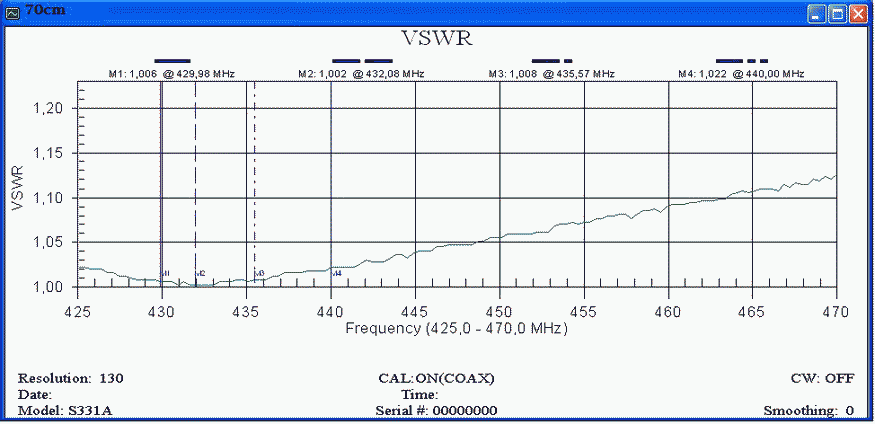| Stacking with Coax | Stacking with Power Splitters |
Stacking with homemade Power Splitters (DK7ZB)
![]()
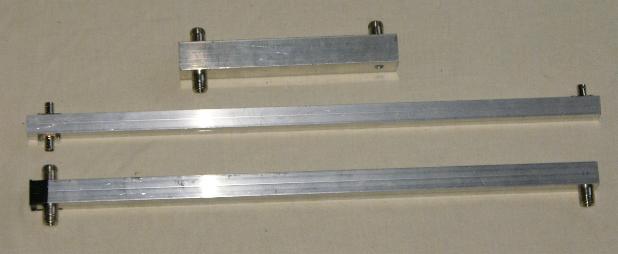
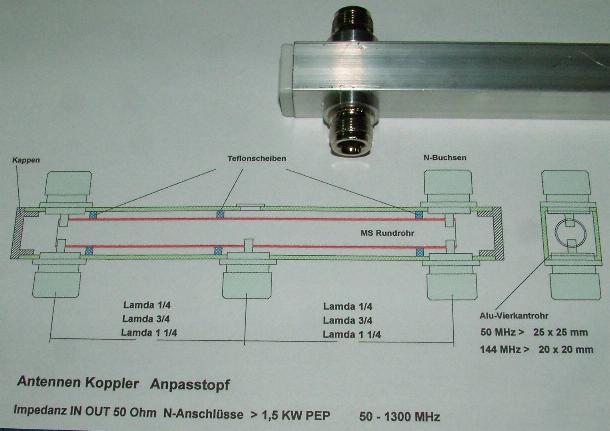
Splitters available by DJ3MF, e-mail: kh-druecker@onlinehome.de
 |
The basis of the power splitters/combiners is a construction of a square tube for the outer conductor and a round tube for the inner conductor. It forms a quarterwave coaxial impedance transformer. The relation D/d influences the resistance/impedance of the splitter. As with the stacking by coax-cables the impedance transformation will be made with lengths of lambda/4. A halvewave-splitter consists of two quarterwave-splitters in parallel.
|
A very good tool to construct power splitters is the program "AppCad" .The program is freeware,
download at http://www.hp.woodshot.com
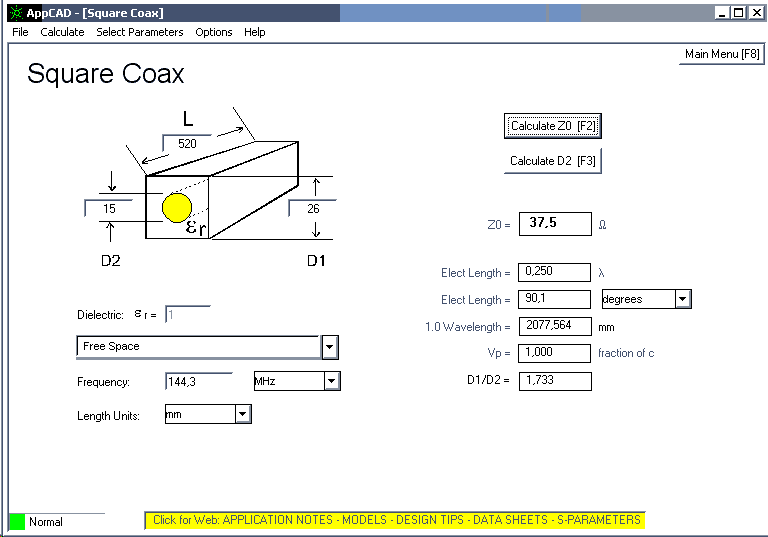
This is a screenshot of "AppCad", you can calculate all parameters for the construction of a power splitter.
![]()
|
|
ZE = Z02 / ZA Z = Z0 (see AppCad)
|
Types of power splitters
|
The λ/4-power splitter (2-way) = Type 1a |
The λ/4-power splitter (4-way)= Type 1b |
|
The λ/2-powersplitter (2-way) = Type 2a |
The λ/2-powersplitter (4-way) = Type 2b |
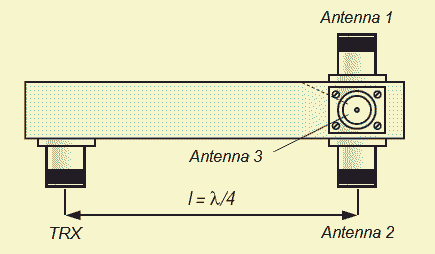
The λ/4-power splitter (3-way)= Type 1c
![]()
Attributes of the Power Splitters
| Type | Ways | Length | ZE | ZA | Z0 |
| 1a | 2x | λ/4 | 25 Ω | 50 Ω | 35,4 Ω |
| 1b | 4x | λ/4 | 12,5 Ω | 50 Ω | 25 Ω |
| 2a | 2x | λ/2 | 50 Ω | 100 Ω | 70,7 Ω |
| 2b | 4x | λ/2 | 25 Ω | 100 Ω | 50 Ω |
![]()
Lengths of the inner Tubes (d) for the Bands 2m, 70cm and 23cm
| Amateurband | Principle | Length inner tube |
| 2 m | λ/4 |
520 mm |
| 70 cm | λ/4 |
173 mm |
| 23 cm | 3λ/4 |
189 mm |
![]()
What dimensions you use for D and d depends on the sources you have in your country.
Use AppCad to calculate suitable power splitters. For Germany I have some combinations in the tables:
Table 1: λ/4
| Type | Square | Inner (D) | Round Tube (d) | Z |
| 1a | 30x2 mm | 26 mm | 15,5 mm | 35,6 Ω |
| 1a | 29,5x2,4 mm | 24,7 mm | 15 mm | 34,4 Ω |
| 1a | 23,5x1,5 mm | 20,5 mm | 12 mm | 36,6 Ω |
| 1a | 19,5x1,5 mm | 16,5 mm | 10 mm | 34,6 Ω |
| 1a | 30x2 mm | 26 mm | 15 mm | 37,5 |
![]()
Table 2: λ/4
| Type | Square | Inner (D) | Round Tube (d) | Z |
| 1b | 25x2 mm | 21 mm | 15 mm | 24,7 Ω |
| 1b | 19,5x1,5 mm | 16,5 mm | 12 mm | 23,7 Ω |
![]()
Table 3: λ/2-Splitter
, 2-way, Type 2a, needed Z=70,7
| Type | Square | Inner (D) | Round Tube (d) | Z |
| 2a | 29,5x2,8 mm | 24,7 mm | 8 mm | 72,1 Ω |
![]()
Table 4: λ/2-Splitter
, 4-way, Type 2b, needed Z=50
| Type | Square | Inner (D) | Round Tube (d) | Z |
| 2b | 30x2 mm | 26 mm | 12 mm | 50,9 Ω |
| 2b | 25x2 mm | 21 mm | 10 mm | 49 Ω |
![]()
Table
5: λ/4-Splitter
, 3-way, Type 1c, needed Z=28,9
| Type | Square | Inner (D) | Round Tube (d) | Z |
| 1c | 25x2 mm | 21 mm | 14 mm | 28,9 Ω |
| 1c | 29,5x2,4 mm | 24,7 mm | 16 mm | 30,6 Ω |
![]()
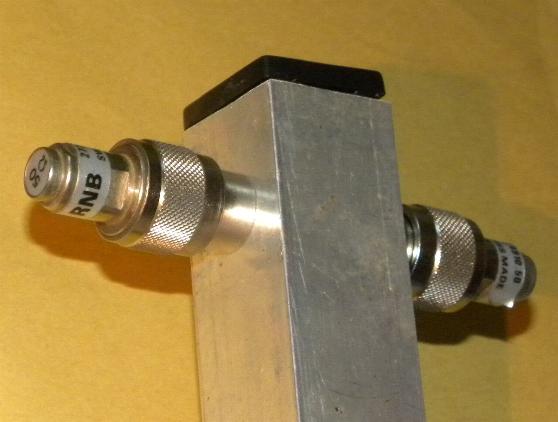 |
The 2-m-splitter Type 1a with two precision resistors 50 Ohm by R&S shows a SWR of 1,01 at 144,3 MHz and 50,6 +/- j0 Ohm (see Marker 2). Built with 30x2 mm and 15,5 mm |
![]()
Practical Construction
It is not easy to connect the inner tube to the coax-sockets. The best way for all materials (you cannot solder aluminium!) is shown in the pictures below:
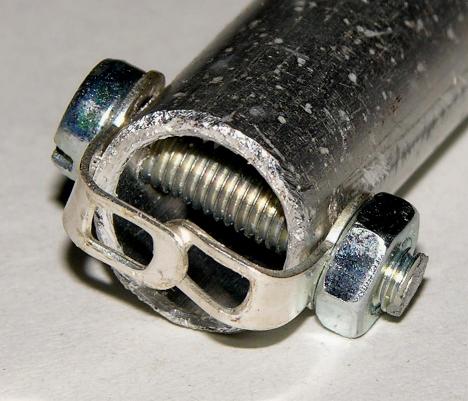
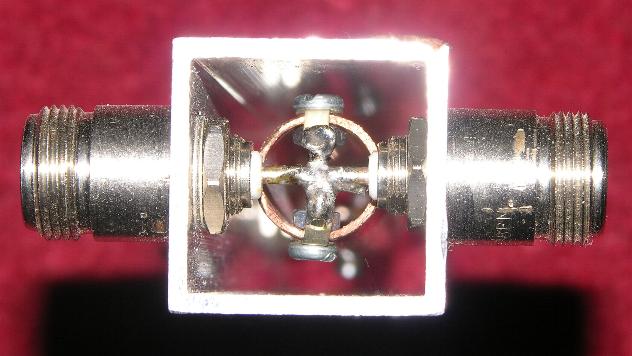
![]()
Splitters built by Piotr, SP5MG


![]()
The measured data of the splitters by Piotr, SP5MG

